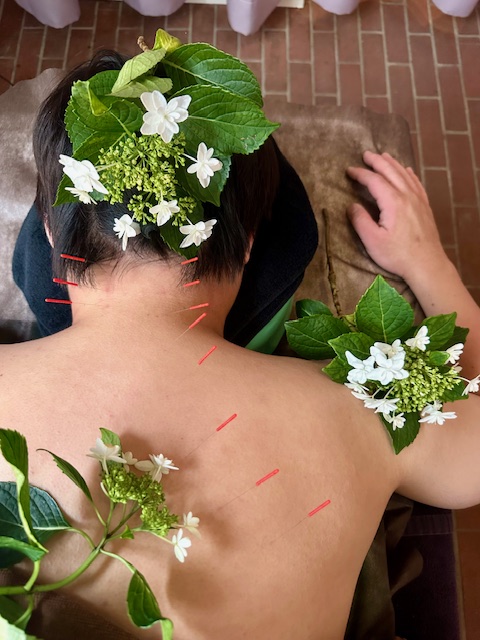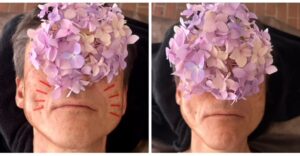首と肩甲骨のコリ
Neck and shoulder blade stiffness

#Neckpain #shoulderbladestiffness
肩甲骨(けんこうこつ)周辺の骨や筋肉の不調から、肩が痛いと感じることがあります。肩甲骨まわりの痛みは肩こりや五十肩などから生じるケースもありますが、肩にある骨や筋肉、腱だけが原因とは限りません。中には内臓の不調からくるケースもあります。
肩は上肢(腕と手)を支えると同時に、これらを動かすことができる仕組みをもつ重要な部位です。肩甲骨は背中の上の方にある逆三角形の平らな骨です。この肩甲骨と腕が、肩関節といわれ、体の中で 動く範囲が最も大きい関節です。肩甲骨まわりが痛い原因としては大きく二つ、「筋肉・骨・関節の不調」と「内臓の不調」に分けられます。
肩関節はさまざまな方向に動かせる構造になっており、たくさんの筋肉や腱(筋肉と骨をつなげる組織)、靭帯(骨と骨をつなげる組織)が集まっています。しかし加齢にともない肩甲骨を動かす筋肉や上腕骨を上げる筋肉が硬くなって肩甲骨の動きが制限されたり、腱板の働きが低下したりします。また、外傷を受け それによって炎症が起こりやすくなり、肩の痛みの大きな原因となるのです。
また、肩関節の周囲には肩にかかる衝撃を吸収したり、関節の動きを滑らかにしたりする働きを持った組織がありますが、これらの弾力が損なわれることでも炎症が起こり痛みを感じます。首から肩にかけて、あるいは首すじから背中にかけて、痛みやこり、張りなどの症状が生じます。
肩こりで頭痛や吐き気をともなう場合もあります。原因はさまざまで、僧帽筋(そうぼうきん)や肩甲挙筋(けんこうきょきん)など肩に関連する筋肉の疲労や、頚椎椎間板ヘルニアなど背骨の病気などによって首の神経が圧迫されて生じる場合があります。
肩を酷使したり、ぶつけたというわけではないのに、突然肩に鋭い痛みが生じて動かせないといった症状がでたら「肩関節周囲炎」の可能性もあります。肩関節周囲炎は「五十肩」とも呼ばれ、関節を構成する骨や軟骨、腱、靱帯などが加齢にともない変性し、肩関節の周囲に炎症を起こすことが主な原因と考えられています。
肩腱板断裂は、腱板の老化や外傷が原因で起こります。腱板の腱が断裂した状態で、肩が動かせなかったり、動かす際に痛みが生じたり、夜間に痛みが現れたりします。外傷によるものは半数で、残り半数ははっきりしていません。高齢者では、日常生活の中でいきなり断裂が起こってしまうこともあったり、運動選手の原因では肩の使いすぎが多いです
老化などで腱板内に石灰(リン酸カルシウム結晶)が沈着することで起こる炎症があります、石灰沈着性腱板炎と呼ばれます。40~50歳代の女性に多く見られます。夜間に肩関節の痛みが突然生じることから始まる場合が多く、睡眠が妨げられ、関節を動かすことができなくなります。石灰は当初は濃厚なミルク状ですが、硬く変化し、たまって膨らんでくると痛みが増してきます。
肩甲骨まわりの痛みは、内臓の不調によって生じる場合もあります。もとの病気から離れたところに現れる痛みを関連痛(放散痛)といいますが、例えば狭心症や心筋梗塞では肩や腕などにも痛みが現れることがあります。また、肝臓で作られた胆汁が十二指腸に至るまでの通り道、胆道(たんどう)に石(結石)ができる胆石症では、半数以上に「胆道痛」といわれる右の肋骨の下やみぞおち、右肩甲骨の下に痛みが生じます。
肩甲骨まわりに痛みを感じたとき、大きく息を吸って痛みが強くなるといった場合は、肺や心臓を覆っている膜や横隔膜などに炎症が起きているかもしれません。このような場合は肩周辺以外の治療が必要になるので医療機関を受診をお勧めします。
鍼灸マッサージ治療では、マッサージで意図的に筋肉や筋を伸ばすことで筋肉の緊張が取り除かれ、血液の流れが良くし、筋(すじ)がやわらかくなって関節の動く範囲を広げます。その結果として、痛みの改善やけがの予防などが期待できます。肩のこりや痛みの最大の原因は筋肉疲労と血行障害です。血行が悪くなると疲労物質が筋肉の中にたまり、末梢神経を刺激して痛みや不快感が生じます。鍼と灸治療で、筋肉が温まると、血流が良くなり疲労物質を排出する助けとなります。
Shoulder pain may be felt due to a malfunction of the bones and muscles around the shoulder blade (scapula). In some cases, pain around the shoulder blade may arise from a stiff shoulder or frozen shoulder, but it is not only caused by the bones, muscles and tendons in the shoulder. Some cases may also result from internal organ problems.
The shoulder is an important part of the body as it supports the upper limbs (arms and hands) and at the same time provides the mechanism for moving them. The shoulder blade is an inverted triangular flat bone in the upper back. The shoulder blade and arm are known as the shoulder joint and have the greatest range of movement in the body. There are two main causes of pain around the shoulder blade: disorders of the muscles, bones and joints and disorders of the internal organs.
The shoulder joint has a structure that allows movement in various directions and is made up of many muscles, tendons (tissue connecting muscle and bone) and ligaments (tissue connecting bone and bone). However, as we age, the muscles that move the shoulder blade and raise the humerus become stiff, limiting the movement of the shoulder blade and reducing the function of the rotator cuff. They can also suffer trauma and thereby become more prone to inflammation, which is a major cause of shoulder pain.
Inflammation and pain can also occur when the elasticity of the tissues around the shoulder joint, which absorb shock and smooth the movement of the joint, is impaired. Pain, stiffness and tension can occur from the neck to the shoulders or from the neckline to the back.
Stiff shoulders may also be accompanied by headaches and nausea. It can be caused by fatigue of the trapezius, levator scapula and other shoulder-related muscles, or by compression of the nerves in the neck due to a cervical disc herniation or other spine disease.
If you suddenly experience sharp pain in your shoulder and cannot move it, even though you have not overworked or bumped it, you may have periarthritis of the shoulder. Periarthritis, also known as ‘frozen shoulder’, is thought to be mainly caused by the age-related degeneration of the bones, cartilage, tendons and ligaments that make up the joint, leading to inflammation around the shoulder joint.
Shoulder rotator cuff tears are caused by ageing or trauma to the rotator cuff. With a torn tendon in the rotator cuff, the shoulder cannot be moved, pain occurs during movement, or pain appears at night. Half of the cases are caused by trauma, while the other half is not clear. In older people, a tear can occur suddenly in everyday life, and in athletes it is often caused by overuse of the shoulder
There is inflammation caused by lime (calcium phosphate crystals) deposits in the rotator cuff due to ageing, etc., called calcinosis rotator cuffitis, which is more common in women in their 40s and 50s. It often starts with sudden onset of pain in the shoulder joint at night, which interferes with sleep and makes it impossible to move the joint. The lime is initially thick and milky, but it turns hard and as it builds up and swells, the pain increases.
Pain around the shoulder blades may also be caused by internal organ problems. Pain that appears away from the original illness is called radiating pain, e.g. angina pectoris or myocardial infarction may also cause pain in the shoulders and arms. In cholelithiasis, in which stones form in the biliary tract, the passageway through which bile produced in the liver reaches the duodenum, more than half the patients experience pain under the right ribs, in the groin or under the right shoulder blade, known as ‘biliary pain’.
If you feel pain around the shoulder blade, such as when you take a big breath and the pain becomes more intense, there may be inflammation of the membranes covering the lungs and heart, or the diaphragm. In such cases, treatment other than in the shoulder area is required and a visit to a medical institution is recommended.
In acupuncture and massage treatment, the intentional stretching of muscles and muscles with massage removes muscle tension, improves blood flow, softens the muscles (striae) and widens the range of movement of the joints. As a result, pain relief and injury prevention can be expected. The main causes of shoulder stiffness and pain are muscle fatigue and impaired blood circulation. When blood circulation is impaired, fatigue substances accumulate in the muscles and irritate the peripheral nerves, causing pain and discomfort. Acupuncture and moxibustion treatment warms the muscles, which improves blood flow and helps to expel the fatigue substances.


